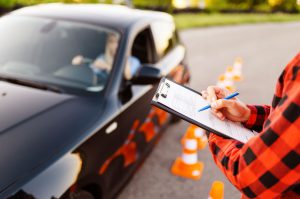Controls, Instruments & Changing Gears
You need to not only know what the different controls and instruments are but know how and when to use them!
It is important when driving that you do not look down at the gear stick when changing gear, although some drivers find this difficult at first it doesn’t take long to achieve. You can practice gear changes sitting in the car with the engine switched off.
In most vehicles the first 4 gears form an ‘H’ appearance on the gear lever. Neutral is the middle line in the ‘H’ formation on the gear stick. The gears run from left to right of the ‘H’, top left being first gear through to bottom right being 4th gear. Most cars now have a fifth gear which is located on the far top – right of the gear lever (to the right of the ‘H’).
To engage reverse gear you sometimes have to either push the gear lever down or lift it up towards you. Different vehicles have different setups. So always check where reverse is on a new vehicle.
1st Gear is used for moving off, manoeuvring and for creeping slowly in traffic and at junctions (approx 0 – 10mph).
2nd Gear is used for moving off down very steep hills, building up speed after moving away and driving at low speeds (approx 10 – 20mph).
3rd Gear is generally used in built up areas (approx 20 – 30mph).
4th Gear is used for driving at speeds generally higher than 30 mph, where there are no hazards to confront.
5th Gear not all vehicles have a 5th. This is normally only used on open roads when traveling constantly at higher speeds which give better fuel economy.
Block Gear Changes (part of Eco Safe driving) Some drivers have a habit of always changing through the gears one-by-one, from 1st through to 5th and from 5th through to 1st. This habit has stuck with some older drivers from when they originally learned to drive many years ago. Today, in modern cars and for everyday on-road driving, it is not generally good practice to use the gears in this way. We can change down the gears in blocks (5th to 2nd or 4th to 2nd. etc); we can equally change up in blocks (2nd to 4th or 3rd to 5th).
For example: If you are driving along at 40 mph in 4th gear, and you want to turn left into a side road you reduce your speed (using your brake) until you are going slowly enough to take the junction safely. When you have slowed down to a safe speed using the brakes, you have to select a gear that will drive the car comfortably at that speed. In most cars the best gear for the job will be 2nd. So, move the gear lever directly to the second gear position skipping 3rd. The benefits of this style of driving include better fuel economy, less overall wear and tear, less driver fatigue on long journeys and more steering control.

The Driving Test
On your driving test the examiner will expect you to:
- Use the controls smoothly and correctly
- Balance the accelerator and clutch smoothly
- Accelerate evenly
- Avoid stalling the car
- Not to ‘ride’ the clutch (keeping your left foot slightly depressed on the clutch pedal)
